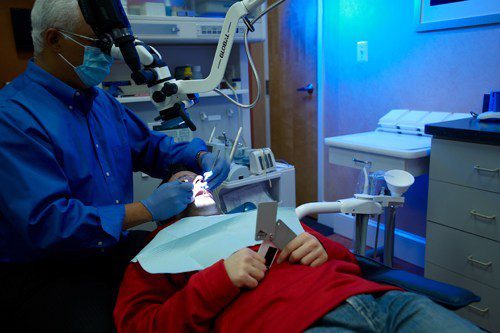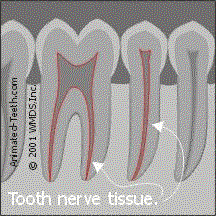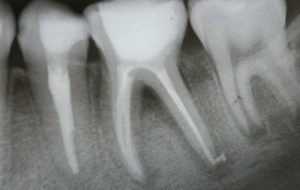Root Canals
What is root canal treatment?
Root canal therapy refers to the process by which a dentist treats the inner aspects of a tooth , specifically that area inside a tooth that is occupied by its “pulp tissue.” Most people would probably refer to a tooth’s pulp tissue as its “nerve.” While a tooth’s pulp tissue does contain nerve fibers it is also composed of arteries, veins, lymph vessels, and connective tissue.
For the purposes of this discussion, so to use terminology that people seem to be most familiar with, we will use the terms “nerve” and “nerve tissue” to refer to a tooth’s pulp tissue.

Where is a nerve located in the tooth?
Teeth are hard calcified objects but their inner aspects are not completely solid. Inside every tooth there lies a hollow space which, when a tooth is healthy, contains the tooth’s nerve tissue. Dentists use the following terms to refer to various portions of this nerve area
The pulp chamber This is a hollow space that lies more or less in the center of the tooth.
The root canals Each tooth’s nerve enters the tooth, in general, at the very tip of its root(s). From this entry point the nerve then runs through the center of the root in small “root canals ” which subsequently join up with the tooth’s pulp chamber.

What is the function of a tooth's nerve tissue?
For the purposes of this discussion, so to use terminology that people seem to be most familiar with, we will use the terms “nerve” and “nerve tissue” to refer to a tooth’s pulp tissue.
A tooth’s nerve tissue does provide a sensory function but this role is probably different from what you expect. Under normal circumstances the nerves inside our teeth provide us with very little information. Yes, when activated by extremes in pressure, temperature, or severe insult (such as a cracked tooth or advancing tooth decay ) teeth do respond with a painful sensation. But under normal circumstances the nerves inside our teeth remain relatively “quiet.”
At this point you might be thinking that if you push on your tooth with a finger or close your teeth together you will feel a pressure sensation. Because of this you might assume that that sensation must come from the nerve inside the tooth. Well, in reality, that sensation comes from the nerves found in the ligament that binds the tooth to the jawbone, not from inside the tooth itself. This implies then, from a standpoint of the normal functions we perform with our teeth, that the presence of a live nerve inside a tooth is somewhat academic. If a tooth’s nerve tissue is present and healthy, wonderful. But if a tooth has had its nerve tissue removed as a part of root canal treatment then that’s fine too. You will never miss it.






